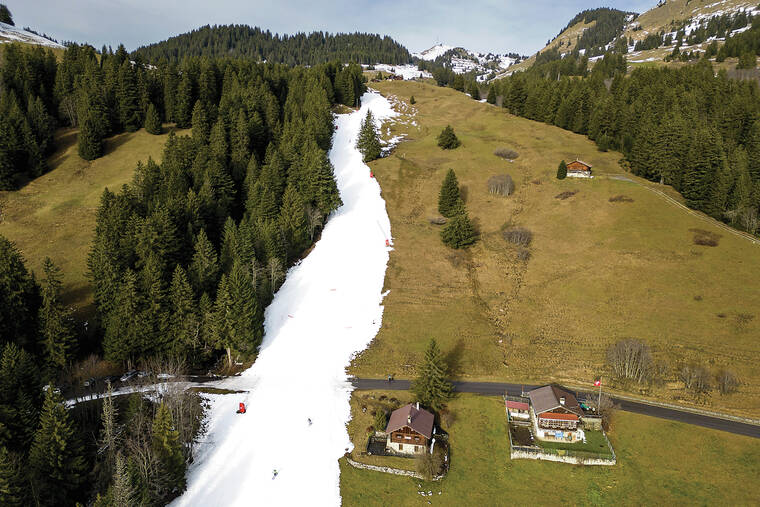GENEVA — Much of the Alps just don’t look right for this time of year. Sparse snowfall and unseasonably warm winter weather in Europe’s central mountains are allowing grass to blanket hillsides across the region, causing headaches for ski slope operators and aficionados of Alpine white.
Patches of grass, rock and dirt were visible Monday in some of Europe’s skiing meccas — like Innsbruck in Austria, Villars-sur-Ollon and Crans-Montana in Switzerland, and Germany’s Lenggries and far beyond. The dearth of snow has revived concerns about temperature upheaval linked to climate change.
On a swath stretching from France to Poland, but with the Alps at the center, many parts of Europe were enjoying short-sleeve weather. A weather map showed Poland racking up daily highs in the double digits Celsius — or more than 50 Fahrenheit — in recent days.
It’s a sharp contrast to the frigid weather and blizzards in parts of the United States late last year.
Swiss state forecaster MeteoSuisse pointed to some of the hottest temperatures ever this time of year. A weather station in Delemont, in the Jura range on the French border, already hit a record average daily temperature of 18.1 degrees Celsius (nearly 65 Fahrenheit) on the first day of the year, over 2-1/2 degrees Celsius higher than the previous record high for January. Other cities and towns followed suit with records.
MeteoSuisse quipped on its blog: “… this turn of the new year could almost make you forget that it’s the height of winter.”
Forecaster Anick Haldimann of MeteoSuisse said a persistent weather system that brought in warmer air from the west and southwest has lingered, locking in warmer temperatures expected to last through the week. While slopes above 2,000 meters (over 6,500 feet) have gotten snow, lower down, “the order of the day is patience” for skiing buffs, she said.
The shortage has been particularly burdensome around Switzerland’s Adelboden, which is set to host World Cup skiing on Saturday, and generally draws 25,000 fans for a single day of racing. Resorts like these look for such races to offer up bucolic wintertime images to draw amateur skiers, but grassy, brown sides to the course can mar the landscape — and dampen the appeal.
Course director Toni Hadi acknowledged that the race will be run on 100% artificial snow this year.
“The climate is a bit changing but what should we do here? Shall we stop with life?” he said by phone, noting that other challenges such as the coronavirus pandemic and war show “life is not easy” these days.
“Everything is difficult — not only to prepare a ski slope,” Hadi said.
The start to 2023 picked up where many countries had already left off: Last year was the hottest on record in both Switzerland and France.
More broadly, the United Nations’ World Meteorological Organization says the past eight years are on track to be the eight warmest on record. Its final tally on global temperature figures for 2022 will be released in mid-January.

